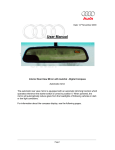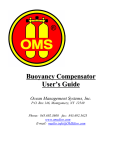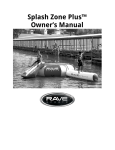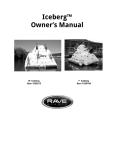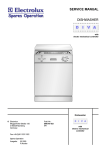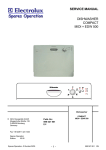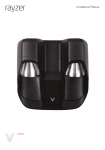Download | The End Wrench > www.endwrench.com
Transcript
> 4 | The End Wrench > w w w. e n d w r e n c h . c o m n 2000, the U.S. Congress passed the Transportation Recall Enhancement,Accountability and Documentation (TREAD) Act to address the growing concerns regarding several major recalls of defective tires that created dangerous and unsafe driving conditions. Much of the focus in the legislation was aimed at the danger of low tire pressure, which can cause a number of problems: poor braking ability, steering control and vehicle stability. Consumers simply do not check their tire pressure frequently or adequately, and many climate, road hazard and difficult driving conditions may cause tire inflation failures. So, the legislation mandates that tire and vehicle manufacturers help improve overall safety. The TREAD Act requires vehicle manufacturers to equip all passenger and light truck vehicles with tire pressure monitor systems (TPMS) by the 2008 model year. These must be capable of alerting the driver if tire pressure falls 25 percent below the recommended psi. I The tire pressure placard and TPMS sticker are found on the driver’s door pillar. Indirect and Direct Types of TPMS There are two basic types of TPMS in use today: indirect and direct. The indirect type uses internal software algorithms in the ABS control module to determine when one wheel is rotating faster than the others.This may be due to low tire pressures causing the tire to have a smaller working diameter, therefore having to turn faster. The system accomplishes this by learning the wheel rotation rate and sending a warning when the rate increases. While this type of TPMS is relatively simple to include – because it doesn’t require additional components – it does have drawbacks. Indirect systems can’t usually detect a problem when all four tires are equally low, which is quite common. Some indirect systems can’t even determine when both tires on a single axle are low. The direct method, such as is used on Subaru vehicles, has proven far more accurate and reliable. Sensors incorporated into the valve stem monitor the inflation pressure and a transponder relays that information to a control module located elsewhere in the vehicle. Each sensor has a built-in battery to provide power to transmit the signal.The control module checks the signals from each wheel and alerts the driver by illuminating a warning light if the pressure in any wheel drops below the safe level. The tire and loading information placard lists the correct tire size and pressure for the vehicle. Subaru Direct TPMS began appearing on Subaru vehicles during the 2005 model year and has now become standard equipment. It’s easy to identify a Subaru vehicle equipped with TPMS, or to spot tires with TPMS sensors.The standard tire placard or decal located on the driver’s door pillar will indicate the pressure range for the tires. Below the tire placard, another tag indicates if the vehicle is equipped with TPMS. The TPMS sticker indicates the presence of the system and pressure adjustment information for cold weather. Continued on page 8. August 2007 • Number 39 | 5 A quick peek at the tire will reveal the unique TPMS valve stem that is an integral part of the wheel pressure sensor. It has a retaining sleeve/nut to secure it in place. Beginning with 2008 Subaru models, a rubber-stemmed TPMS wheel sensor will appear, but for 2005-2007 models, the gray plastic version applies. This photo of the direct type of TPMS sensor used on Subaru vehicles shows the sensor and transmitting body that is located within the wheel, as well as the valve section that protrudes through the wheel. A tire with TPMS is easy to spot.The plastic retaining sleeve is a giveaway. How it Works When the ignition is turned on, the TPMS warning light will illuminate for approximately two seconds while it checks the tires. If there is no problem, the light will go out. If any tires are found to be under-inflated, the warning light will burn steadily. A flashing TPMS warning light 8 | The End Wrench > (every three seconds) indicates a problem with the system. Mounting a spare tire that is not equipped with a TPMS sensor will also cause the light to flash. When the vehicle begins to move and the wheels start rotating, a centrifugal switch inside the sensor activates the pressure measurement and signal sending functions.At about 7 mph, the sensor begins taking pressure measurements every 30 seconds and transmits the results once each minute to the control module, located under the driver’s seat.This electronic “handshake” keeps the wheels in touch with the control module. Each wheel sensor has its own unique ID code, so the module can recognize it. When the vehicle is parked and has not moved for fifteen minutes, the sensors stop transmitting a signal to prolong the life of the internal sensor battery. w w w. e n d w r e n c h . c o m Tire Pressure Monitor Systems If the tire pressure drops below the minimum setting (approximately 27 psi), the sensor does not send its signal to the control module. The module will then illuminate the warning light. The warning light will not, however, indicate which tire is low, so all tires need to be checked with an accurate tire pressure gauge. Even though the culprit tire may be visibly evident, all other tires must be checked also. After inflating the tires to the correct pressure, the vehicle must be driven to 20 mph or more.The warning light will go off after a few minutes if the pressure is now correct. Diagnostics Although the TPMS warning light does not indicate which tire is low, or what the system problem might be, diagnostic trouble codes can be retrieved from the vehicle’s system to pinpoint the problem.The TPMS diagnostic trouble codes listed below can help you identify where the fault lies. Registering Wheel Sensor ID Code After any service that moves the wheel from its original position on the vehicle, the use of a TPMS ID code registering device is required to re-establish communication between the wheel sensor and the TPMS control module. Such a device triggers the sensor to transmit an ID code signal to the TPMS control module so it can recognize the sensor and identify its location. This does not apply if you are simply removing the wheel for tire service, brake work or any other under car procedure. As long as you put the wheel back in its original position, the TPMS warning light will not illuminate. The recommended Subaru TPMS ID code registering tool (J-45295) is available through your local N.E.W. Horizons Dealer or online at http://subaru.spx.com. DTC Item Contents of Diagnosis 11 12 13 14 21 22 23 24 31 32 33 34 41 42 43 44 51 52 53 54 61 FL air pressure decrease FR air pressure decrease RR air pressure decrease RL air pressure decrease No FL transmitter data No FR transmitter data No RR transmitter data No RL transmitter data FL transmit pres data abnormal FR transmit pres data abnormal RR transmit pres data abnormal RL transmit pres data abnormal FL trans function code abnormal FR trans function code abnormal RR trans function code abnormal RL trans function code abnormal FL transmit battery low voltage FR transmit battery low voltage RR transmit battery low voltage RL transmit battery low voltage Vehicle speed is abnormal Front Left tire pressure low Front Right tire pressure low Right Rear tire pressure low Left Rear tire pressure low Data cannot received be from FL sensor Data cannot received be from FR sensor Data cannot received be from RR sensor Data cannot received be from RL sensor FL sensor data contents are abnormal FR sensor data contents are abnormal RR sensor data contents are abnormal RL sensor data contents are abnormal FL function code has error FR function code has error RR function code has error RL function code has error FL transmitter battery voltage is low FR transmitter battery voltage is low RR transmitter battery voltage is low RL transmitter battery voltage is low The vehicle speed signal is not input to control module with the speed more than 25 km/h (15.53 mph) A TPMS wheel sensor registering tool forces the wheel sensor to transmit a signal to the control module to be recognized. Clearing diagnostic trouble codes and resetting the TPMS control module is performed by the use of a scan tool, such as the Subaru Select Service Monitor III. Clearing TPMS Codes This readout on a Subaru Select Monitor shows three TPMS DTCs: Front Left tire pressure is low (11); Left Rear tire pressure is low (14) and the vehicle speed signal is not being sent to the control module (61). Erasing the diagnostic trouble codes (DTCs) and resetting the control module is accomplished by the use of a sophisticated scan tool, such as the Subaru Select Monitor III. Because the TPMS diagnostic procedures for each Subaru model may vary and would be too lengthy to include here, refer to the specific service manual for the vehicle you are servicing, or log onto the Subaru Technical Information System website at http://techinfo.subaru.com. August 2007 • Number 39 | 9 Tire Pressure Monitor Systems 1) 2) 3) 4) 5) Transmitter Nut Wheel Tire Push This diagram shows the correct method of removing the TPMS transmitter/ sensor prior to breaking the tire away from the wheel. 1) 2) 3) 4) Service Notes Here are some tips and hints to remember when servicing vehicles equipped with TPMS: ■ Cold Weather: A drop in temperature during cold weather will cause tires to deflate as the air inside them contracts.This may cause the TPMS warning light to illuminate. Adjust the tire pressure accordingly. If the tire pressure is adjusted inside a warm shop (60-70 deg. F.) and the outside ambient temperature is much colder, add one extra psi for every 10 deg. F. difference. ■ Tire Rotation: Tire rotation demands that all tires be re-registered with the TPMS control module, using an ID code registering tool. ■ Aftermarket Tires: Changing to tires that are not the same as the originals may, or may not, affect the operation of the TPMS, depending on the pressure range of the tire. Logically, tires with a lower pressure range than the original tires will set off the TPMS warning light. Be sure to re-install the TPMS wheel sensors in their original positions or you’ll have to reset the system. ■ Changing to a Spare Tire:When removing a flat or damaged road tire with a TPMS wheel sensor and installing a spare tire that is not equipped with TPMS, the warning light will illuminate and flash until the original or new road tire is re-installed and the ID code is re-registered with the TPMS control module. ■ Mounting Tires on Wheels: Special care must be taken when removing or mounting tires to wheels equipped with TPMS sensors. The sensors can be easily damaged or destroyed if direct leverage is applied to the stem or sensor body. The air should be bled from the tire, the retaining nut removed and the valve pushed into the tire before breaking the tire away from the wheel. 10 | The End Wrench > Transmitter Grommet Nut Wheel Here’s the proper placement of TPMS transmitter/sensor installation. Note: The air should be bled by depressing the valve core.The valve core should not be removed from the valve as the use of a special valve core torque tool is required to avoid over-tightening the valve, which would result in failure of the pressure sensor. A new grommet must be used when re-installing the sensor to the wheel when mounting a tire. Install the transmitter/sensor to the wheel by aligning it with the valve hole, then tighten the retaining nut to 5.53 ft. lbs. (7.5 N•m). Tires should always be mounted using an approved tire machine. To prevent breaking the sensor/trans-mitter, set the tire changer boom or shovel in the position shown in the diagram on page 11. After filling the tire to the correct pressure, install the wheel on the vehicle and register the transmitter ID to the TPMS control module, if needed. ■ Fillling Tires: When filling tires, the air supply should be clean and dry.This is exceptionally critical for TPMS tires as any sediment or moisture can affect the precision workings of the sensor and transmitting devices. Take care to blow off the area around the valve stem to rid the area of dirt. If a valve stem does not have a cap, gently blow air into the valve to remove any dirt or dust. ■ Aerosol Inflators with Sealant: Using a can of aerosol tire inflator with sealant is not an option for TPMS. The gummy sealant will clog up the valve and pressure sensing port of the wheel sensor. The warning light will illuminate and you’ll end up replacing the sensor. Make sure your customers understand this. w w w. e n d w r e n c h . c o m ■ Sensor Battery Life: The tiny integrated lithium battery in the wheel sensor has an estimated life of 10 years or 100,000 miles. When a sensor battery’s voltage gets to the low limit, it will cause the control unit to generate a 51, 52, 53 or 54 diagnostic trouble code, depending on which tire it happens to be in. Rest assured, if one sensor battery is low, the others are sure to follow shortly. If any tire work is performed as the vehicle nears the 10 year or 100,000 mile mark, it would be good preventive maintenance to replace the sensors. ■ Wheel Sensor/Control Module Communication: Warn customers to never place metal objects, such as tools or aerosol spray cans, under the driver’s seat near the TPMS control module as these items may interfere with the signal reception from the wheel sensors. Also, the valve stem of the wheel sensors serves as the transmitting antenna, so don’t replace the original valve caps with any other type that may interfere with the signal. ■ 1) 2) 3) 4) Transmitter Turn table rotation direction 90° Tire changer boom Always follow the instructions for mounting a tire to a wheel with a TPMS transmitter/sensor in place. August 2007 • Number 39 | 11









